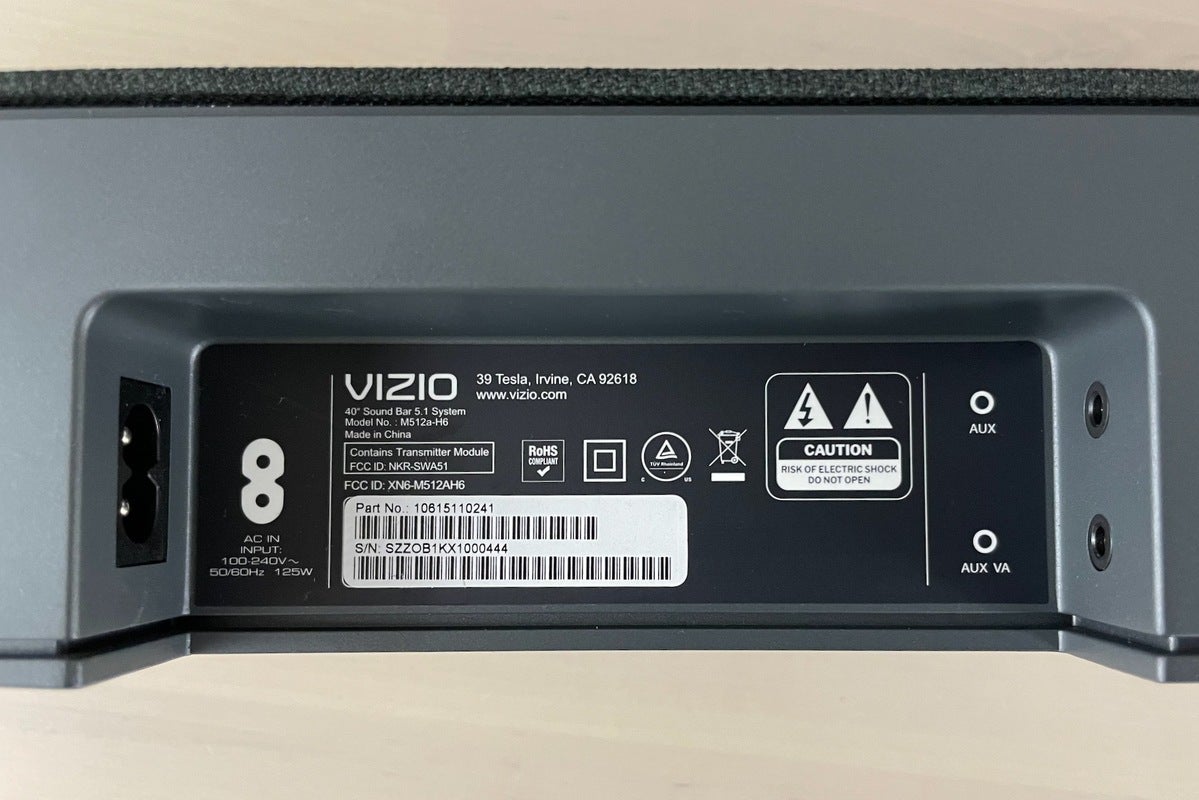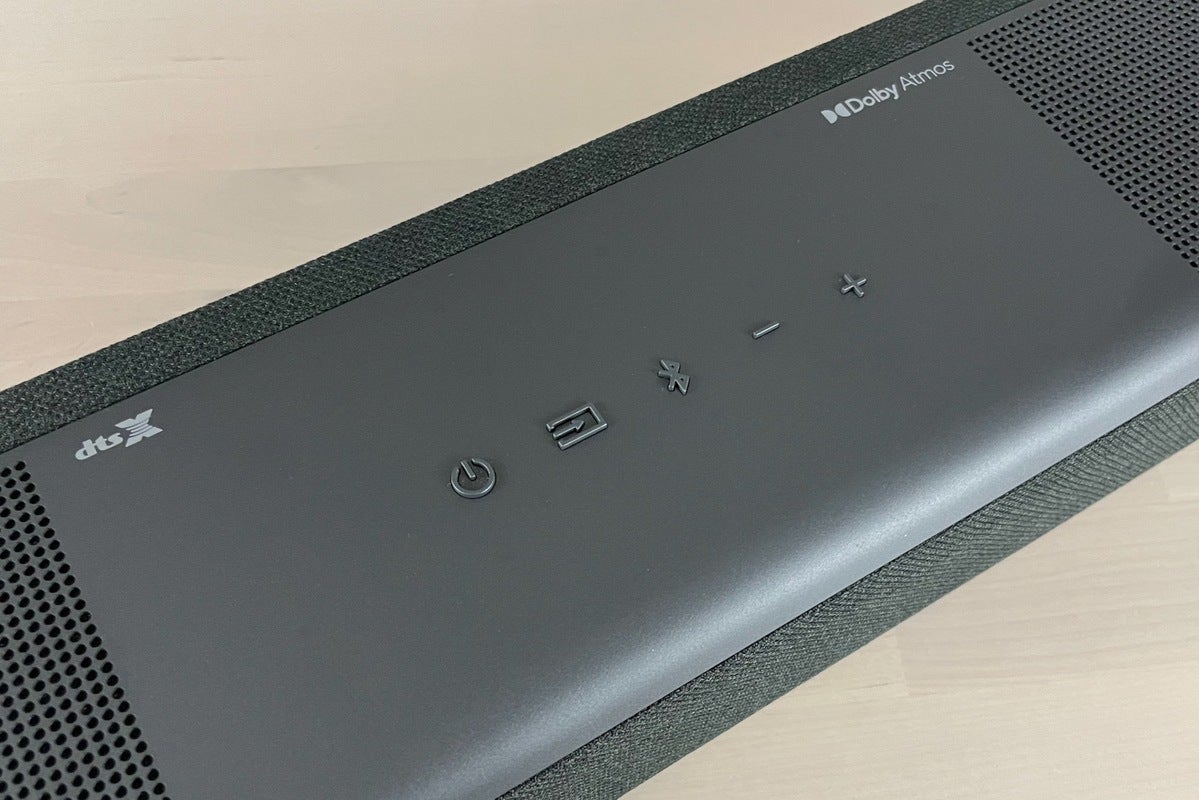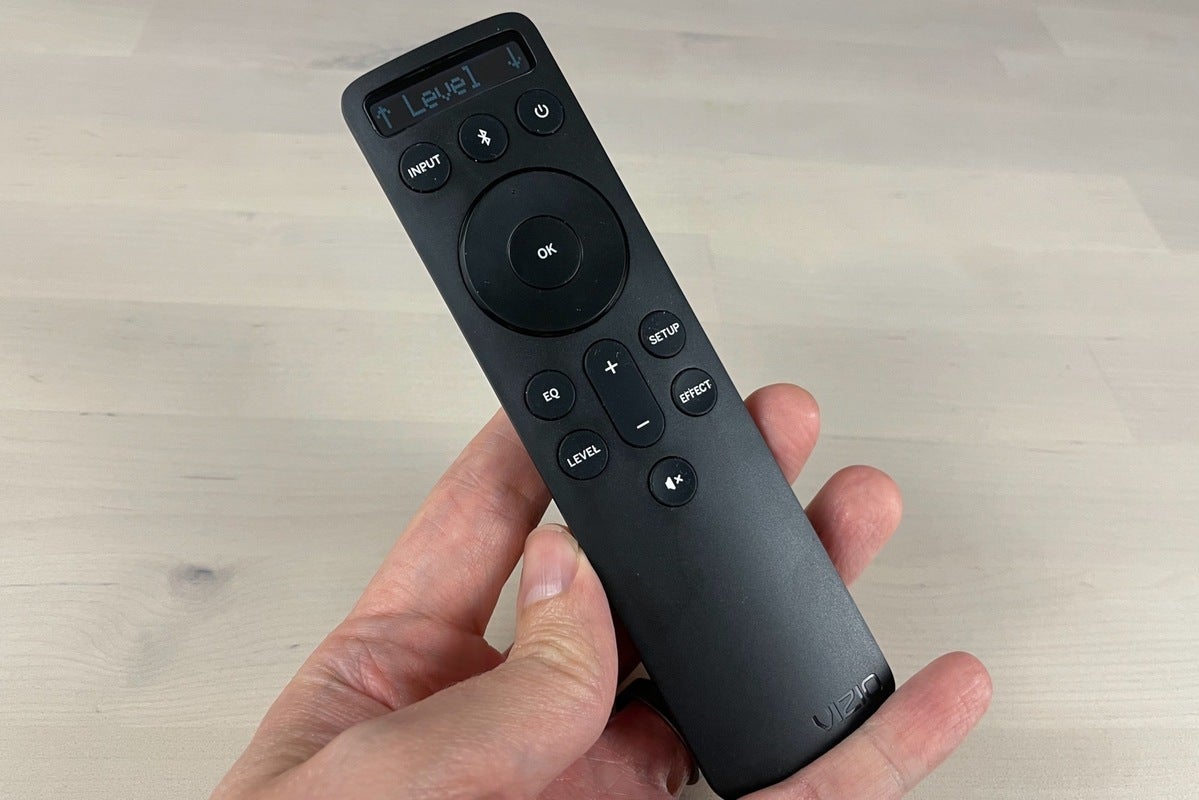What Vizio’s mid-range M512a-H6 lacks in Wi-Fi connectivity, it makes up for in big, exciting, room-filling sound. Slated to ship in July for a list price of $450, this 5.1.2-channel M-series soundbar from Vizio is easy to set up, offers plenty of discrete audio adjustments, and delivers immersive Dolby Atmos and DTS:X sound courtesy of upfiring drivers.
Now, a sub-$500 soundbar like the M512a-H6 (which Vizio calls an “M-series” soundbar, sitting between its high-end P-series and budget-priced V-series models) will necessarily mean settling for some compromises—in this case, no Wi-Fi support, which means you’ll have to do without AirPlay 2 and Chromecast functionality, as well as support for native audio streaming. The good news is that you can add a voice assistant by connecting a smart speaker via a 3.5mm jack or Bluetooth, a nifty feature that’s new to Vizio’s 2021 soundbars. If you really want a Vizio soundbar with Wi-Fi abilities, check out the $999 Elevate, which connects to Wi-Fi and supports Chromecast streaming.
This review is part of TechHive’s coverage of the best soundbars. Click that link to read reviews of competing products, along with a buyer’s guide to the features you should consider when shopping.
Specifications
The Vizio M-Series M512a-H6 is a 5.1.2-channel soundbar, meaning it has physical drivers for the left, center, right, left surround, and right surround channels (the “5” in the “5.1.2” designation), as well as a wireless subwoofer for low-frequency effects (the “.1”) and two upfiring drivers for Dolby Atmos and DTS:X height cues (the final “2”).
The main soundbar unit houses a total of eight drivers, including a 2.19-inch full-range driver and a 0.79-inch tweeter for each of the left, center, and right channels, while the left and right height channels each get their own three-inch upfiring drivers.
Those two upfiring drivers bounce sound off your ceiling to produce Dolby Atmos and DTS:X height effects, an easier and more affordable alternative to installing height speakers in your ceiling. A ceiling that’s too high, too low, or vaulted could blunt the effectiveness of the upfiring drivers; in that case, you could turn on DTS Virtual:X, a virtualized 3D audio mode that doesn’t rely on upfiring or in-ceiling speakers. We’ll discuss Dolby Atmos, DTS:X, and DTS Virtual:X more in the performance section.
Moving along, the wireless subwoofer gets a 6-inch driver, while the two surround speakers each get a 1.61-by-2.22-inch full-range driver. In all, that’s 11 drivers for the entire system.
Vizio didn’t supply detailed dimensions for the main M512a-H6 soundbar housing, but measuring it with my tape measure, it came out to roughly 40 x 4 x 2.6 inches (WxDxH). That’s relatively wide for a soundbar, stretching almost the entire length of my 55-inch LG C9 OLED. And when it’s sitting in front of the TV, it’s tall enough to block a sliver of the screen. In comparison, the 9.92 x 8.3 x 11.69-inch (HxWxD) subwoofer (Vizio did give us the measurement specs for that component) is fairly compact as far as wireless subwoofers go.
Besides simply plunking the soundbar in front of your TV, you can also mount it under the TV, and Vizio has helpfully included mounting screws and brackets for both the main soundbar unit and the surround speakers, along with a mounting template. You also get a generous cable kit, including an HDMI cable (which not all soundbar manufacturers bother to put in the box), along with an optical cable, a 3.5mm-to-3.5mm cable, a stereo RCA-to-3.5mm cable, and four cable ties.
Inputs and outputs
In the left rear cavity of the M512a-H6 are two HDMI connectors, one of which is an input while the other serves either as an output or an HDMI eARC interface. That gives you two options for connecting the soundbar to your TV via HDMI: one, you could connect a video source (such as a streaming video player, a Blu-ray player, or a game console) to the HDMI input, and then send video and audio to your TV via the HDMI output (4K HDR passthrough is supported), or two, you could connect all your video sources to your TV and then send audio down to the soundbar via the HDMI eARC interface. Because the M512a-H6 supports eARC, you’ll be able to send lossless audio formats such as Dolby TrueHD and DTS-HD Master Audio to the soundbar via HDMI, provided your TV also supports eARC.
Besides its HDMI connections, the soundbar comes with an optical (Toslink) input, a USB-A port (which only supports the playback of MP3 and WAV audio files), and a 3.5mm auxiliary jack.
A final input on the M512a-H6 deserves special mention: a second 3.5mm jack dedicated to connecting a smart speaker, such as an Amazon Echo or Echo Dot. You can also connect a smart speaker to the M512a-H6 via Bluetooth, ideal for Google Nest speakers (like the Nest Mini) that lack 3.5mm output jacks. Once connected, you’ll be able to channel your voice assistant and any other audio from the smart speaker through the soundbar’s drivers. The soundbar will also lower the volume from its active video input when you use the smart speaker’s wake word, making it easier to hear the voice assistant’s reply. Pretty cool, but remember that while you can hear a smart speaker through the M512a-H6’s drivers, you won’t be able to use voice commands to control the soundbar itself.
 Ben Patterson/IDG
Ben Patterson/IDG
A second 3.5mm jack (labeled “AUX VA”) in the rear of the M512a-H6 is dedicated to connecting a smart speaker, such as an Amazon Echo. You could also connect a smart speaker that lacks a 3.5mm output, such as the Google Nest Mini, to the soundbar via Bluetooth.
Setup
So, let’s get this out of the way: The Vizio M512a-H6 doesn’t support Wi-Fi at all, which means no audio casting via Apple AirPlay 2 or Chromecast, no native support for streaming music services, and no way to control the soundbar’s settings via your phone. On the bright side, it means you won’t have to deal with connecting the M512a-H6 to your home wireless network, a process that (for me, at least) has been a headache with other Vizio soundbars.
Instead, you can jump straight to placing the soundbar in front of your TV (or, as I mentioned earlier, mounting it under your TV) and powering it on with the included power cord. Next, you’ll need to connect the subwoofer’s power cord (so no, the subwoofer isn’t completely wireless) and decide where to place it—which, in the case of Vizio soundbars with wireless surround speakers, requires some strategizing.
Rather than wirelessly connecting to the main soundbar unit or plugging into a separate wireless transmitter, the M512a-H6’s surround speakers plug into the wireless subwoofer. (That’s a common design for Vizio’s 5.1- and higher soundbars, by the way.) That means you’re faced with a couple of less-than-ideal placement options for the subwoofer: either next to your sofa, thus simplifying cable management but potentially placing the sub too close for comfort, or in a more traditional spot behind your TV, which means you’ll need to string cable for the connected surround speakers across your floor. The good news is that Vizio has been generous with the actual speaker cables, which are each roughly 30 feet long, and they’re also thin enough to hide under a carpet. In the end, I opted for a subwoofer spot that most users will likely choose out of convenience: next to the sofa, about three feet away and a foot or so from the wall.
Once the pre-paired main soundbar unit, subwoofer, and wireless surrounds are powered up, they should all connect to each other automatically; that’s how it worked for me, anyway. There’s also a manual pairing process if the automatic pairing doesn’t work properly.
Buttons, remote control, and indicators
On top of the main Vizio M512a-H6 cabinet are buttons for power, input, Bluetooth (which you can press and hold to enter pairing mode), and volume up/down—nothing unusual here.
 Ben Patterson/IDG
Ben Patterson/IDG
The top of the Vizio M512a-H6 comes with buttons for power, volume, Bluetooth, and input select.
The M512a-H6’s remote comes with a single-line, backlit LCD at the top, which lets you scroll through settings and options such as trimming the speaker levels, adjusting the surround balance, testing the drivers, and switching surround modes. While the backlit display is handy for using the remote in the dark, you’ll still need to memorize the position of the various EQ, Level, Setup, and Effect buttons, which are not backlit. Luckily, you can easily find the prominent volume and mute controls, which sit beneath a four-way navigational pad, by touch.
 Ben Patterson/IDG
Ben Patterson/IDG
The M512a-H6’s included remote comes with a single-line backlit LCD,
On the left edge of the M512a-H6’s front panel is a column of 10 LEDs that serves a variety of functions. For example, it can display the main volume level, as well as show you the level of individual speakers and channels as you’re adjusting them. A secondary light at the base of the column can glow different colors depending on the detected audio format—for example, green for Dolby Atmos, white for Dolby Audio, and amber for DTS. The main column of lights dims after a few seconds as does the secondary light, and I never found them distracting while viewing.
Sound modes
The Vizio M512a-H6 comes with your typical sound modes, including Movie, Music, Direct, and Game. Besides the main audio modes, there’s also a Surround Mode that can disable the surround speakers and remix the audio for the remaining drivers (there are plenty of users who simply never use the surround speakers, I’m told), and you can also deactivate Height Mode to switch the height drivers off (if, for example, your ceiling isn’t suitable for upfiring drivers).
If you do decide to nix the surround or height speakers, you can turn on DTS Virtual:X, an audio processing technology that (as I mentioned earlier) can fool your ears into thinking they’re hearing height and surround cues without the need for height or surround speakers. Now, one might ask why would you bother paying extra for a soundbar with height and surround speakers if you don’t plan on using them. That’s a good question, but apparently it happens, and in that case, DTS Virtual:X—which sounds reasonably good, but not as good as using actual height and surround drivers—is there if you want it.
Besides the audio, surround, and height modes, there’s a DTS TruVolume setting that narrows the dynamic range of the sound, ideal for taming the sounds of explosions or other loud effects, while a night mode dials down low-frequency effects for late-night viewing. There’s no one-touch voice control, but there is a Dialogue Level setting under the Level menu on the remote.
Performance
I tested the Vizio M512a-H6 using a wide range of video sources, including the UHD Blu-rays of Star Wars: The Empire Strikes Back and Blade Runner 2048, which both have Dolby Atmos soundtracks; the 4K Blu-ray of Apollo 13, which features DTS:X sound; the standard Blu-ray of Titanic, with DTS-HD Master Audio tracks; and the iTunes versions of Top Gun and 1978’s Superman, which each have Dolby Atmos sound. Besides movies, my wife and I also binged-watched more episodes of The West Wing and Younger than I care to count. For most of my movie and TV testing, I stuck (unsurprisingly) with the Movie, Surround, and Height modes all enabled.
As for the M512a-H6’s overall performance, well… wow. We’re talking big, bold, aggressive audio with great dynamics, plenty of pop, clear dialogue, and lots of boom—perhaps too much boom, which is an issue I’ve encountered on other Vizio soundbars with subwoofers that sit next to the sofa.
In the Battle of Hoth sequence in The Empire Strikes Back, the sound of cascading snow showers as an Imperial Walker toppled to the ground triggered some nice height cues, as did the ice pellets falling from a collapsed ceiling in the Rebel base. I also loved how the M512a-H6 sounded during the Apollo 13 launch sequence, with the exhaust from the towering Saturn V rocket seeming to billow above and around my ears, along with a sharp pop as the tower jettisoned from the top of the spacecraft. The dogfight with Viper in Top Gun was a sonic showpiece, with the jets thrillingly soaring over the mountains and roaring into the frame. (I should note that my wife, normally not a soundbar fan, gave me a slack-jawed look during this scene, and pointedly said: “This soundbar’s good.”) Finally, dialogue sounded clear and natural during The West Wing and Younger, while incidental music cues sounded warm and lively without being pushy.
Now, before I sound too gushy here, I should point out that the Vizio’s bass response can be a little much at times. I remedied this by dialing back the subwoofer level nearly all the way, which still yielded a solid punch without veering into overly boomy territory. Of course, another option would be to move the subwoofer further away from the sofa (I placed the sub about three feet away) or across the room behind the TV, which (again) means you’ll have to deal with the speaker wires. But in my case, a little tweaking of the subwoofer levels did the trick.
Bottom line
Vizio’s M512a-H6 soundbar delivers powerful, vibrant sound for a reasonable price, complete with Dolby Atmos and DTS:X support, an easy setup process, and plenty of adjustments for tinkering with audio settings—which is a good thing, considering the soundbar’s tendency to push the bass into boomy territory. You will have to settle for no Wi-Fi or casting support, however, which is par for the course when it comes to $500-ish soundbars.
"sound" - Google News
May 31, 2021 at 05:00PM
https://ift.tt/3wJfyMd
Vizio M-Series M512a-H6 review: This mid-range soundbar delivers big, dynamic sound - TechHive
"sound" - Google News
https://ift.tt/2MmdHZm
Shoes Man Tutorial
Pos News Update
Meme Update
Korean Entertainment News
Japan News Update

No comments:
Post a Comment